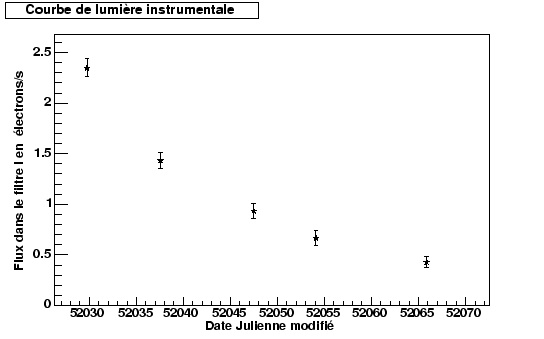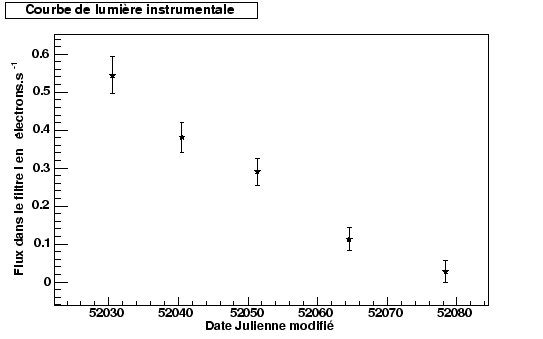Contents
Figure 8.25
shows the lightcurve of 2000fr built with the observations of space
follow-up. The galaxy host of the supernova is sufficiently far away
from the supernova to make it possible to make an estimate of fluxes by
aperture photometry corrected for the opening. We checked that the
use of a larger aperture did not involve an appreciable increase
in the flux of the supernova.
Figure 8.25: Curve of light
of 2000fr. This supernova has a redshift of 0.543. It was
discovered in a very early way what made it possible to obtain a
significant follow-up space and a sampling of the lightcurve out of
I very good. Fluxs are expressed in a number of photoelectrons a second
for a aperture of  . Fluxs of this supernova were determined by a aperture of 5 pixels.
. Fluxs of this supernova were determined by a aperture of 5 pixels.
 |
Figure 8.26
represents the lightcurve of 2001go obtained by subtraction of
images. Flux is estimated by aperture on the subtraction. Once
again, we do not note significant variation of flux by increasing the
value of the aperture.
Lastly, figure 8.27
represents the lightcurve of 2001gn obtained by subtraction of flux
of opening centered on the current images and the reference. Once
again, it was checked that the increase in the aperture did not
involve significant variation of flux.
Figure 8.26: Curve of light
of 2001go. This supernova has a redshift of 0.552. Fluxs
are expressed in a number of photoelectrons a second for a ray of
opening of  .
Fluxs of this supernova were determined by a aperture of 5
pixels on a subtraction of the images of follow-up and image of
reference.
.
Fluxs of this supernova were determined by a aperture of 5
pixels on a subtraction of the images of follow-up and image of
reference.
 |
Figure 8.27: Curve of light
of 2001gn. This supernova has a redshift of 1.1. Fluxs are
expressed in a number of photoelectrons a second for a aperture
of  .
Fluxs of this supernova were determined by a subtraction of flux of
opening of 4 pixels of the images of follow-up and image of reference.
.
Fluxs of this supernova were determined by a subtraction of flux of
opening of 4 pixels of the images of follow-up and image of reference.
 |
Contents Julien Raux 2004-05-04

